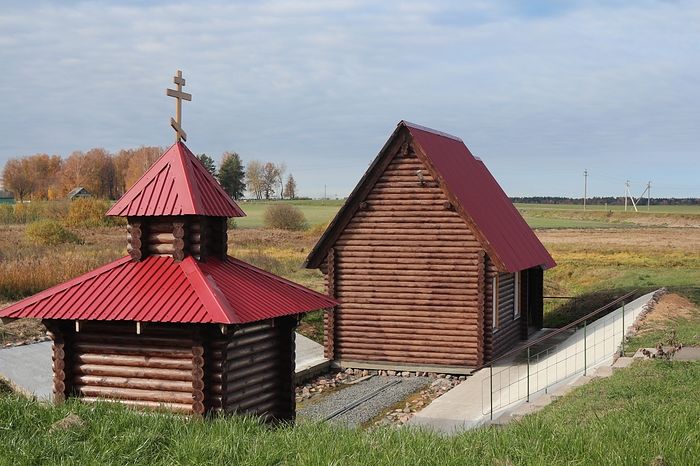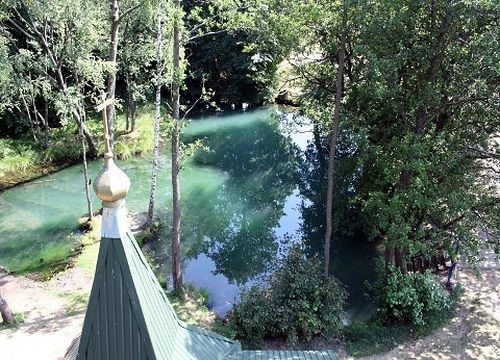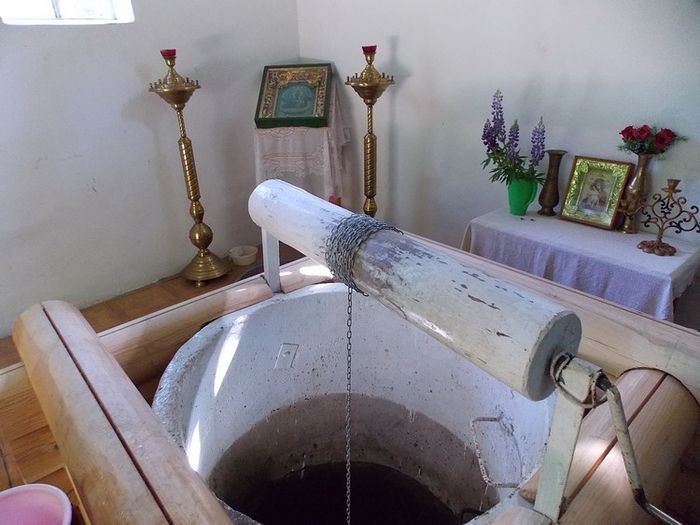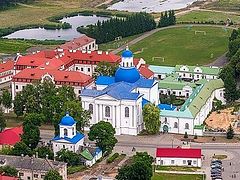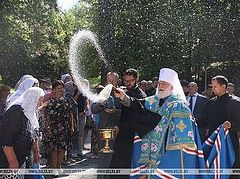Through the sprawling groves,
Through the fields I make haste to you.
To the chapel, where the wind swells
To dawn, in the crystal sky.
There stands a chapel at the springs,
Where God breathes white light!
Curling locks from the birches hang,
To be warmed by God’s rays.
Holy water glistens like silver,
With birds and flowers in the glare.
Grant me, O spring, to drink my fill from you!
To drink of spiritual purity!
The sun climbed upon my shoulders,
Bidding farewell to dawn in the east.
My soul is healed of callousness,
By a swallow of this living holy water!
(Alexander Popov)
A gift from God
There are places where all cares disappear and a man feels peace and quiet. The grace of God is felt there; inner joy and an extraordinarily lightness remain. People rush here every day with prayer, receiving spiritual consolation and help. They are considered a wondrous miracle of Orthodoxy, known as holy springs. Incurable diseases are cured here, the most complicated situations in life are resolved, hearts are softened, and adversity, grief, and disquiet melt away. The soul becomes calm and peaceful.
Holy springs are places where the grace of God is given to man in abundance both spiritually and bodily, but first the Lord desires the spiritual healing of man. If people don’t go to church, don’t participate in the Sacraments of the Church, don’t try to observe the commandments of God and to perform works of mercy, but they hope for a miracle, it can happen only by a special mercy and the providence of God. Most often, a miracle occurs where the soul is prepared to receive grace. As in agriculture: A large harvest comes from a field that has been well worked.
Many springs are consecrated by the appearance of a saint or icon, or the Theotokos herself. Molebens for the blessing of waters are served at these places every year. The water at most of the springs is distinguished by its exceptional purity, visibility, wonderful taste, and high content of healthy minerals. It doesn’t freeze in winter and doesn’t heat up in the summer, remaining the same temperature year-round.
There are about 200 such springs on the territory of Belarus.
The most famous holy springs are in Zhirovichi in the Slonim District. There are several there, the first of which appeared in 1470.
Wondrous and near
In the Mogilev Province, five miles from the city of Slavgorod, is found the unique Blue Spring. The spring has been known since pre-Christian times and according to tradition, it was here that the Radimichi tribe was baptized. It is the largest spring in all of Europe. Its water is bluish-turquoise, and light as if shines up from the depths—the water comes to the surface, passing through the thickness of ancient chalk deposits. Scientists attest that the spring is of a very rare type—it is like a well, going to a depth of 500-650 feet in a vertical shaft. Every day, about 1,320,860 gallons of the purest water rise to the surface—a true lake!
According to the Institute of Geochemistry and Geophysics of the Belarusian Academy of Sciences, the water of the Blue Spring is a benchmark of pure underground water and is of a high drinking quality.
At the source of the spring stands a church, consecrated in honor of the Holy Maccabean Martyrs.
To the spring—for forgiveness
On the territory of the Bobruisk Diocese, fifteen miles from the city of Osipovichi, twenty-eight miles from the city of Bobruisk, not far from the village of Kokhonova is found the Proscha Tract. Proscha is a clearing in the forest, in the center of which is a church, with a chapel built over the spring nearby and a well-kempt place for immersing yourself the holy spring. The church is dedicated to the Lifegiving Spring Icon of the Mother of God. According to legend, in the eighteenth century, two blind elders were walking from the village of Koritnoe and got lost in the forest. They turned to God in prayer and suddenly heard the babbling of water. The blind men bent down to the spring, washed their eyes, and regained their sight. Returning to Koritnoe, they told the priest about the miracle that occurred. A church was built at the spring, which was burned down in 1928. However, people did not forget the spring and would come with prayer. The authorities tried to fill it with cement, but the water still made its way through. The church has been restored, and there are monks living there. People ask for forgiveness of sins and the intercession of the Theotokos here. This is why the forest plot received the name of Proscha [from the Belarusian word for “forgiveness”—“прощение, proschenie”—Trans.].
The tract is famous for healings from oncological diseases of varying severity, and childless couples have conceived after visiting it.
There are buckets by the chapel at the spring with which every pilgrim, having removed his clothes, prayerfully douses himself from head to foot three times with water from the holy spring.
The holy water complex in honor of St. Alexander Nevsky near the village of Patseva Sloboda in the Kirovsk District
About two and a half miles from the Orthodox Church in the city of Kirovsk, in the direction of the village of Patseva Sloboda, is the Krinitsa recreational area—a joint project of the Holy Protection Parish and the District Executive Committee, having an historical foundation. In the national archive of the Republic of Belarus there is mention, dating to the eighteenth century, about how at the Church of St. Nicholas in the village of Patseva Sloboda (built in the sixteenth century) there is a “Jordan River,” where the blessing of water and cross processions are held on the feast of Theophany. This holy place was historically restored and cleared and on September 17, 2017, it was consecrated in honor of St. Alexander Nevsky. The holy water complex is a chapel over the spring, where the water flows into a well-kempt font for immersing oneself.
It should be noted that it is the only holy spring equipped with a font for fully immersing oneself in the water on the territory of the Bobruisk-Bykhov Diocese.
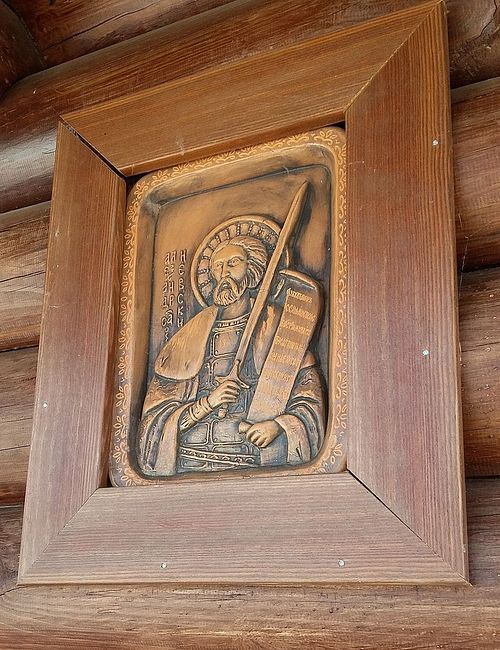 Outdoor icon of St. Alexander Nevsky at the chapel of the holy water complex
Outdoor icon of St. Alexander Nevsky at the chapel of the holy water complex
The holy Right-Believing Prince Alexander Nevsky (thirteenth century) is a great man of prayer and soldier, known for his victories over the enemies of Rus’ and the defense of Orthodoxy. People pray to him for any need, and especially for admonishing enemies and offenders, for military personnel, for the strengthening of faith, and for help in training. The prince’s relics are venerated in the St. Alexander Nevsky Lavra in St. Petersburg.
Heading for the holy spring
Before drinking or pouring the holy water over yourself, or immersing yourself in it, read the prayer posted for pilgrims at the spring or another prayer you know, and then, in your own words, entreat God for what you need.
The rules of conduct at the holy spring include:
-
You must be wearing a cross;
-
Men enter the font separately from women (even if they are married);
-
Women may not go into the font when they are in the midst of their “feminine days.” There is a custom of going into the water in a chemise, to then wear this garment in times of sickness for spiritual consolation;
-
Traditionally, people immerse themselves three times (including their heads, if able), crossing themselves each time. Immersion in a holy spring should be done with faith and reverence with the prayer, “In the name of the Father, and of the Son, and of the Holy Spirit,” or with any prayer addressed to the Lord, the Theotokos, or the saints. You can pray with your own words;
-
With a large crowd of pilgrims, when you have to wait for your turn, you should quietly pray, not shout, not argue, and not condemn, remembering the sanctity of the place;
-
It is necessary to observe cleanliness and clean up your garbage.
-
It is forbidden to smoke, drink alcohol, be drunk, litter, pollute the spring, throw coins, or curse on the territory of the holy spring. Leaving the font, you should cross yourself before the icon and thank God and the saints.

